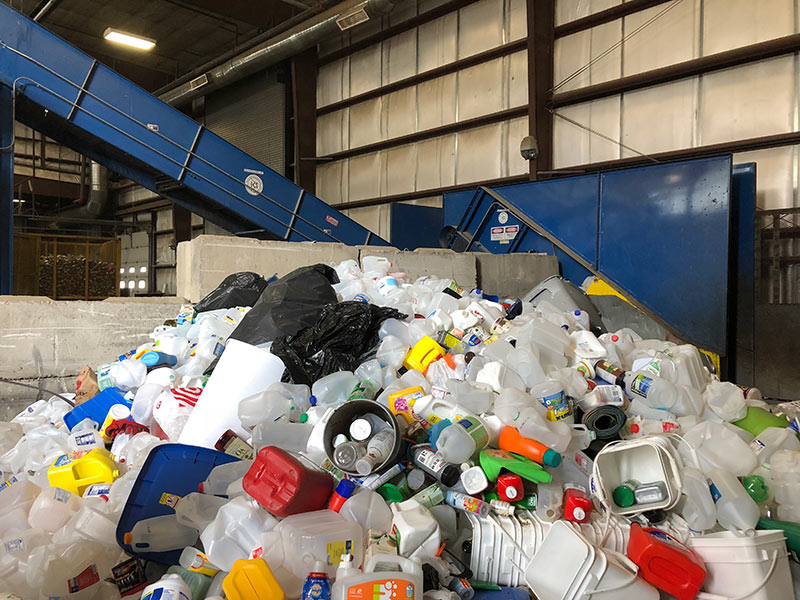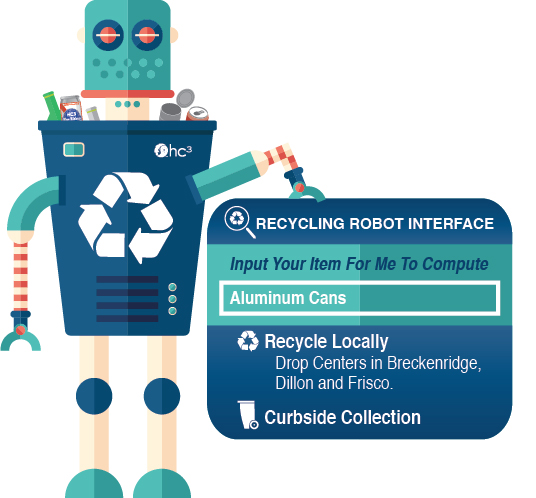
- Vitalii Homon
- June 19, 2018
- Ask Eartha
Dear Eartha,
Recycling has been in the news lately, and it reminded me about a thread I saw on Facebook last year. Can you set the record straight — what happens to my recyclables after I put them out on the curb?
Sarah, Breckenridge
Thanks for your question, Sarah. I set my recycling container on the curb just this morning, and when I get home this evening, the container will be empty. But that’s only part of the story. Tracing the trajectory of recyclable materials offers a good lesson in how recycling works as well as the importance of recycling properly.
FROM THE CURB…
If you pay for single-stream recycling at home, it means you can mix your recyclables together in one container for pick up by a hauler. The exception is glass which should be recycled separately at one of the local recycling centers (more on those later). Put your container outside on your pick-up day, and you’re done … but the materials are just beginning their journey.
I’ve heard people claim that they don’t believe recyclables actually get recycled because they see containers emptied into trash trucks. But hauling companies don’t typically have separate trucks for trash and recycling; the same trucks are used for both material streams. These companies do operate separate routes for trash and recycling, so what matters more is that your trash and recyclables aren’t emptied into the same truck at the same time. If that happens, call your hauler. Note that there are a few split trucks with compartments for both trash and recycling.
…TO THE SCRAP Now, a few acronyms coming your way: Your hauler will transport the recyclables to the Materials Recovery Facility (MRF, pronounced “merf”) at the Summit County Resource Allocation Park (SCRAP) for processing. A MRF is a facility that receives and processes recyclables, although the level of sophistication varies from one MRF to another. The SCRAP is the location for the county’s landfill, MRF and composting operations. Rest assured, if you see trucks with recyclable material heading toward the landfill, that doesn’t mean they’ll end up buried. Instead, they’re deposited on the floor of the MRF. There, SCRAP employees push the truck load of material onto a conveyor belt and it’s fed into a baler. Baled into large blocks, the material is loaded onto a tractor trailer, and once full, the trailer is sent down to Denver.
Now, a few acronyms coming your way: Your hauler will transport the recyclables to the Materials Recovery Facility (MRF, pronounced “merf”) at the Summit County Resource Allocation Park (SCRAP) for processing. A MRF is a facility that receives and processes recyclables, although the level of sophistication varies from one MRF to another. The SCRAP is the location for the county’s landfill, MRF and composting operations. Rest assured, if you see trucks with recyclable material heading toward the landfill, that doesn’t mean they’ll end up buried. Instead, they’re deposited on the floor of the MRF. There, SCRAP employees push the truck load of material onto a conveyor belt and it’s fed into a baler. Baled into large blocks, the material is loaded onto a tractor trailer, and once full, the trailer is sent down to Denver.
…TO DENVER
Summit County’s bales of single stream recycling end up at Waste Management’s MRF in Denver. When they arrive, the bales are broken apart, and the material is loaded onto the MRF’s sorting machinery. There are great videos online that show what the sorting process looks like and how the equipment is used to separate the different materials into piles that are packaged and sold to end users — the companies that purchase recyclables to turn them into new products.
This is where the importance of proper recycling comes into play. Even though recycling is an activity many of us feel good about participating in, we have to remember that it’s also a business. End users purchase material from MRFs, and if that material isn’t clean or it’s not all the same type, the material is thrown away, wasting time and money for both the MRF and the end user. If end users consistently purchase contaminated material from MRFs, they’ll be less likely to use recycled material at all, undermining the purpose of recycling. As a recycler, you help ensure the efficiency of the process by rinsing out your containers and by only recycling what is locally accepted.
DROP-OFF RECYCLING The recycling process looks a bit different at the local drop-off centers. At these locations, the recycler (you) sorts items into different containers depending on the material type. SCRAP staff picks up the containers when they’re full and drives them to the MRF. The MRF has equipment to sort one type of material at a time, so employees can remove any non-recyclable items — for example, snow sleds and garden hoses — that end up in the mix. Once sorted, the separated materials are baled and stored until the SCRAP has enough of one type of material to sell. Unlike the single-stream process, Summit County sells the separated material directly to end users. This is yet another reason why it’s important to recycle properly — our community benefits when you only recycle what’s accepted at the recycling drop-sites.
The recycling process looks a bit different at the local drop-off centers. At these locations, the recycler (you) sorts items into different containers depending on the material type. SCRAP staff picks up the containers when they’re full and drives them to the MRF. The MRF has equipment to sort one type of material at a time, so employees can remove any non-recyclable items — for example, snow sleds and garden hoses — that end up in the mix. Once sorted, the separated materials are baled and stored until the SCRAP has enough of one type of material to sell. Unlike the single-stream process, Summit County sells the separated material directly to end users. This is yet another reason why it’s important to recycle properly — our community benefits when you only recycle what’s accepted at the recycling drop-sites.
ROCKY TO THE RESCUE
Whether you have single-stream recycling at home, use the drop-off centers or a combination of both, High Country Conservation Center’s Rocky the Recycling Robot is a great resource for your recycling questions. Simply input an item into the search bar, and Rocky will compute the proper method of disposal. Rocky can be found at HighCountryConservation.org/recycle.
Even with all the fancy sorting machines, it’s up to us — the recyclers — to make sure we recycle properly and ensure that recycling is a viable industry. So definitely keep recycling, and please do it right!
Ask Eartha Steward is written by the staff at the High Country Conservation Center, a nonprofit organization dedicated to waste reduction and resource conservation. Submit questions to Eartha at info@highcountryconservation.org.
